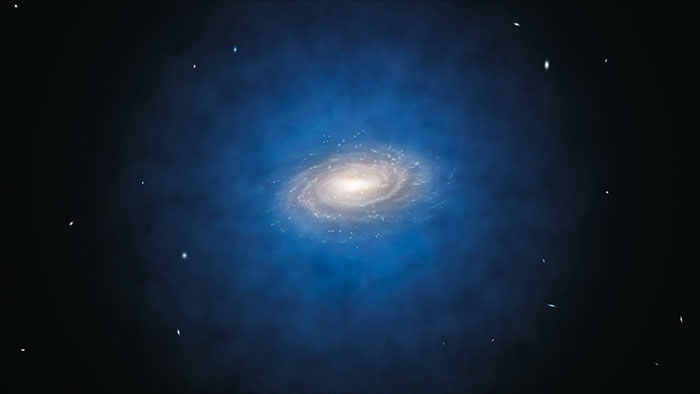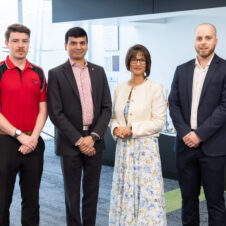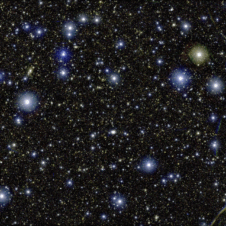Australian astronomers used a method developed almost 100 years ago to discover that the weight of dark matter in our own galaxy is 800 000 000 000 (or 8 x 1011) times the mass of the Sun.
They probed the edge of the Milky Way, looking closely, for the first time, at the fringes of the galaxy about 5 million trillion kilometres from Earth.
Astrophysicist Dr Prajwal Kafle, from The University of Western Australia node of the International Centre for Radio Astronomy Research, said we have known for a while that most of the Universe is hidden.
“Stars, dust, you and me, all the things that we see, only make up about 4 per cent of the entire Universe,” he said.
“About 25 per cent is dark matter and the rest is dark energy.”
Dr Kafle, who is originally from Nepal, was able to measure the mass of the dark matter in the Milky Way by studying the speed of stars throughout the galaxy, including the edges, which had never been studied to this detail before.
He used a robust technique developed by British astronomer James Jeans in 1915 — decades before the discovery of dark matter.
Dr Kafle’s measurement helps to solve a mystery that has been haunting theorists for almost two decades.
“The current idea of galaxy formation and evolution, called the Lambda Cold Dark Matter theory, predicts that there should be a handful of big satellite galaxies around the Milky Way that are visible with the naked eye, but we don’t see that,” Dr Kafle said.
“When you use our measurement of the mass of the dark matter the theory predicts that there should only be three satellite galaxies out there, which is exactly what we see; the Large Magellanic Cloud, the Small Magellanic Cloud and the Sagittarius Dwarf Galaxy.”
University of Sydney astrophysicist Professor Geraint Lewis, who was also involved in the research, said the missing satellite problem had been “a thorn in the cosmological side for almost 15 years.”
“Dr Kafle’s work has shown that it might not be as bad as everyone thought, although there are still problems to overcome,” he said.
The study also presented a holistic model of the Milky Way, which allowed the scientists to measure several interesting things such as the speed required to leave the galaxy.
“Be prepared to hit 550 kilometres per second if you want to escape the gravitational clutches of our galaxy,” Dr Kafle said.
“A rocket launched from Earth needs just 11 kilometres per second to leave its surface, which is already about 300 times faster than the maximum Australian speed limit in a car!”
Further Information:
ICRAR is a joint venture between Curtin University and The University of Western Australia with support and funding from the State Government of Western Australia.
Dr Prajwal Kafle conducted this research at both the University of Sydney and the International Centre for Radio Astronomy Research at The University of Western Australia.
Original publication details:
‘On the Shoulders of Giants: Properties of the Stellar Halo and the Milky Way Mass Distribution’ P. R. Kafle, S. Sharma, G. F. Lewis, and J. Bland-Hawthorn. Published in the Astrophysical Journal October 10th, 2014. Available at: http://iopscience.iop.org/0004-637X/794/1/59/
Pre-print paper available at: http://arxiv.org/abs/1408.1787
Image and Animation:

Artist’s impression of the Milky Way and its dark matter halo (shown in blue, but in reality invisible).
Credit: ESO/L. Calçada, there is also an animated version and higher resolution versions.
This animation shows a supercomputer simulation of a galaxy like the Milky Way and its invisible dark matter halo. We zoom in to the galaxy and can see knots of dark matter where we would expect to see many satellite galaxies, but they don’t exist in the real Universe. That’s the missing satellite problem. Credit: Prof Chris Power and Dr Rick Newton, ICRAR. Music by Reuben Christman (www.reubenchristman.com).
Contacts:
Dr Prajwal Kafle
ICRAR – UWA
Ph: +61 8 6488 7203
E: prajwal.kafle@icrar.org
Kirsten Gottschalk
Media Contact, ICRAR
Ph: +61 8 6488 7771
M: +61 438 361 876
E: kirsten.gottschalk@icrar.org
UWA Media Office
Ph: +61 8 6488 7977

